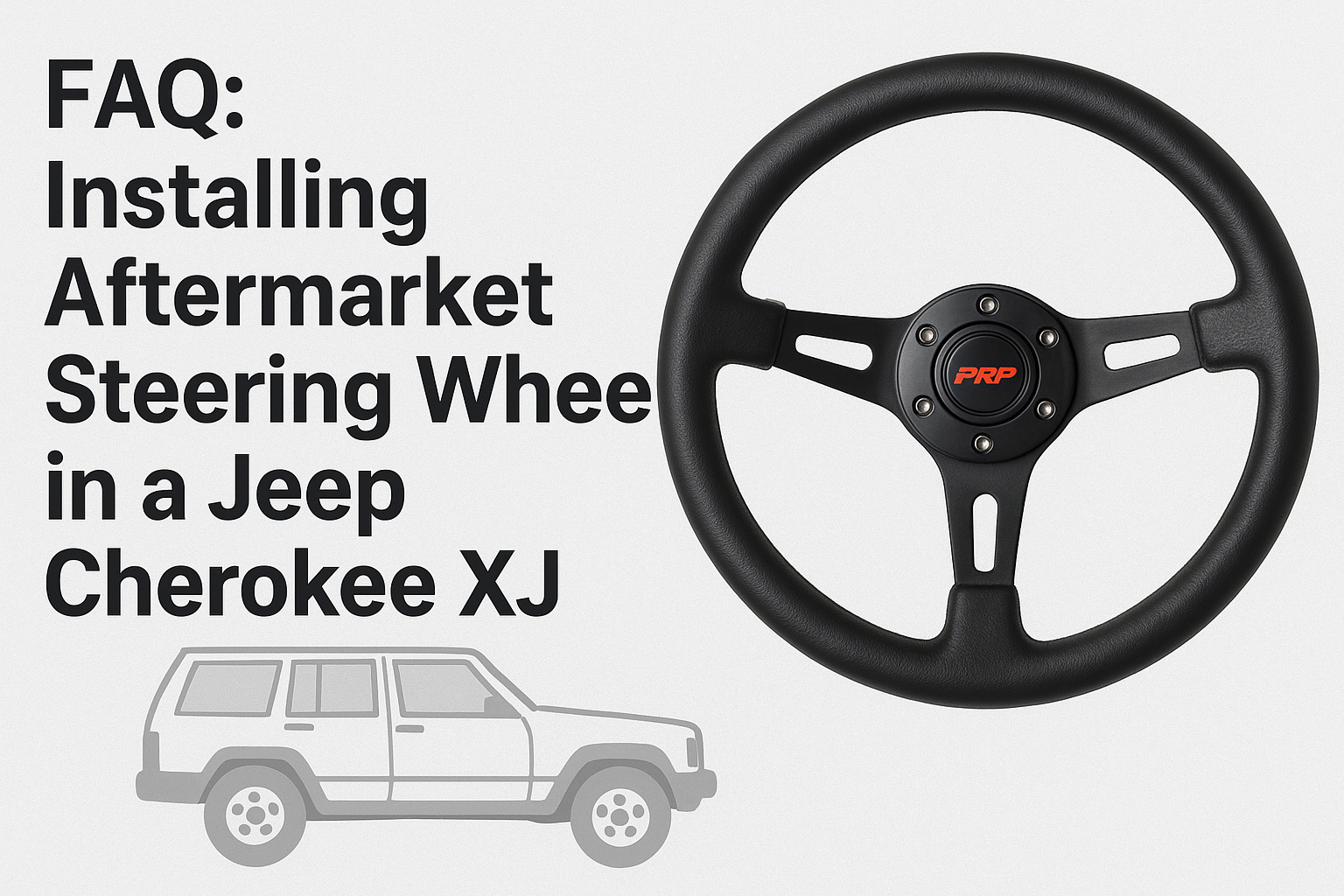FAQ: Installing Aftermarket Steering Wheels in a Jeep Cherokee XJ
Sep 18th 2025

Helpful answers and step-by-step guidance for choosing and installing an aftermarket steering wheel in your XJ. If you're shopping for wheels and hubs, check out our Steering Wheels for XJ Cherokee category.
What are the basic components needed to install an aftermarket steering wheel in an XJ?
To install an aftermarket steering wheel you will generally need:
- The aftermarket steering wheel itself (check diameter and style).
- A compatible hub adapter (boss kit / wheel hub) that matches the XJ’s steering shaft spline, bolt pattern, and your new wheel’s mounting pattern.
- Optional: quick-release or locking hub (if desired) — this usually requires a specific adapter.
- Tools: socket and ratchet, torque wrench, and possibly a steering wheel puller depending on the stock wheel design.
- Wiring or horn adapter if you want to preserve horn functionality (older XJs don’t have driver airbags in the wheel, but horn wiring still matters).
What size and bolt pattern is standard on a Jeep Cherokee XJ?
Common reference points for XJ installations:
- Stock steering wheel diameter is approximately 15 inches (≈ 38 cm).
- The steering column commonly accepts hub adapters designed for the XJ’s interface and typical 6-bolt wheel patterns — always verify the hub matches your wheel’s bolt pattern.
How do I choose the right hub adapter?
Match these attributes when selecting a hub adapter:
- Steering shaft spline / interface — the adapter must mate properly to the XJ’s input shaft.
- Bolt pattern — hub must match the bolt pattern of the new wheel (e.g. 6-bolt).
- Offset / depth — determines how far the wheel sits from the driver; choose for a comfortable reach and clearance.
- Quick-release compatibility — if you plan to use a quick release, confirm wheel + hub compatibility.
- Safety & legal considerations — preserve horn function and be aware of any local rules about removing safety equipment (airbags, etc.).
What are the steps to install the wheel after having the necessary parts?
General installation procedure (high level):
| Step | What to do |
|---|---|
| 1 | Disconnect the battery to avoid accidental horn shorting or electrical issues. |
| 2 | Remove the old steering wheel: remove horn pad (if applicable), unscrew the center nut, use a steering wheel puller if necessary. |
| 3 | Install the hub adapter: align properly on the shaft splines and secure. Torque the center nut per factory or hub manufacturer spec. |
| 4 | Mount the new steering wheel to the hub: align bolt holes, install bolts, and torque to the wheel or hub manufacturer’s specification. |
| 5 | Reconnect the horn wiring (if applicable) and verify proper contact. |
| 6 | Reconnect the battery and test the wheel: check for play, confirm centering, turn fully to test for binding, and verify horn function. |
What torque specs or safety tips should I follow?
- Always torque the center nut (that secures the hub to the steering shaft) to the specification in the factory service manual or the hub manufacturer instructions. Incorrect torque can cause looseness or damage.
- Torque wheel-to-hub bolts to the manufacturer’s recommended values. Use thread locker if the manufacturer recommends it.
- Ensure wiring for the horn and any steering-mounted controls is routed without pinching and is securely connected.
- After installation, check for steering wheel play, centering, and that there is no interference with the instrument cluster, column stalks, or other components.
- Re-inspect fasteners periodically — off-road vibration can loosen components faster than street driving.
Will installing a smaller or larger steering wheel affect steering feel or control?
Yes. Changing diameter or grip thickness changes leverage and steering input required:
- A smaller wheel gives quicker inputs (less hand travel for a given steering change) and can feel twitchier.
- A larger wheel or thicker grip offers more leverage at low speeds, which can be helpful off-road, but it may reduce steering responsiveness for precise maneuvers.
- Choose a wheel that fits your driving style — street, trail, or mixed use — and that provides comfortable reach and visibility of gauges.
Are there legal or inspection considerations for changing a steering wheel?
Yes — consider the following:
- Modifications that remove or alter safety equipment (airbags on modern vehicles) can be illegal in some jurisdictions. The XJ typically did not have a modern airbag in the wheel like newer vehicles, but check local laws and inspection rules anyway.
- Ensure the horn works and the new wheel does not block signals, gauges, or column controls.
- Some inspections require original or approved safety equipment — verify local requirements if your vehicle is subject to annual safety inspections.
How much does a quality aftermarket steering wheel + hub cost for the XJ?
Prices vary by brand, material, and features:
- Aftermarket wheels (leather, suede, alloy) commonly range from roughly $200–$300, depending on brand and finish.
- Hub adapters typically run around $100–$200 depending on style, hub brand, and whether they include quick-release compatibility.
NRG XJ Cherokee Steering Wheel Hub Adapter
For available wheels and hub options, see our Steering Wheels - XJ Cherokee category.

